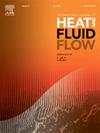Impact of blade twisting and tip clearance on centrifugal pump performance under air–water two-phase flow
IF 2.6
3区 工程技术
Q2 ENGINEERING, MECHANICAL
International Journal of Heat and Fluid Flow
Pub Date : 2024-12-10
DOI:10.1016/j.ijheatfluidflow.2024.109682
引用次数: 0
Abstract
The performance characteristics of a centrifugal pump were investigated experimentally for different conditions of air–water two-phase flow. A 3D semi-open impeller (with twisted blades) and a geometrically similar 2D semi-open impeller (with straight elliptical blades) were employed to compare the pump behavior using each of them, revealing the influence of the blade twisting. Additionally, the effect of the tip clearance gap on the performance of each impeller was investigated by employing either a standard or an increased gap. A rotational speed of 1450 rpm was set for all experiments. The performance of the pump was reported and described for either a constant gas volume fraction or a constant air flow rate at the pump inlet. Possible hysteresis effects were studied by approaching the desired operating conditions using different procedures. The head degradation behavior, the pump surging conditions, and the flow instabilities were considered as well. The two-phase flow regimes were recorded and identified for all the considered cases using a high-speed recording system. The results show that for single-phase flow, both impellers perform similarly, with the 3D impeller showing slight advantages at part-load and the 2D impeller excelling at near-optimal and overload conditions. For two-phase flows with high gas volume fractions, the 3D impeller maintains better performance at overload, while the 2D impeller performs better at part-load conditions. Increasing the gap slightly improves performance for gas volume fractions between 5% and 7% in both impellers. Additionally, the 2D impeller demonstrates a stronger ability to suppress and delay surging and flow instabilities compared to the 3D impeller, making it preferable for applications requiring stable operation across a range of gas volume fractions and load conditions.
求助全文
约1分钟内获得全文
求助全文
来源期刊

International Journal of Heat and Fluid Flow
工程技术-工程:机械
CiteScore
5.00
自引率
7.70%
发文量
131
审稿时长
33 days
期刊介绍:
The International Journal of Heat and Fluid Flow welcomes high-quality original contributions on experimental, computational, and physical aspects of convective heat transfer and fluid dynamics relevant to engineering or the environment, including multiphase and microscale flows.
Papers reporting the application of these disciplines to design and development, with emphasis on new technological fields, are also welcomed. Some of these new fields include microscale electronic and mechanical systems; medical and biological systems; and thermal and flow control in both the internal and external environment.
 求助内容:
求助内容: 应助结果提醒方式:
应助结果提醒方式:


